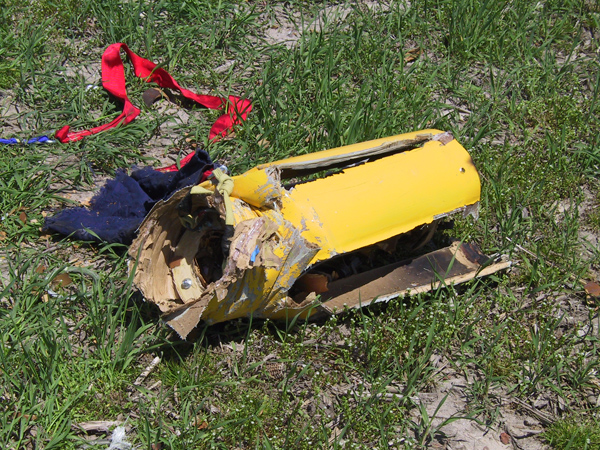
The motor vendor is the next decision. Choosing a rocket motor vendor is much like choosing your child’s pediatrician, the church you will patronage, or who you will vote for in the next election. Once you purchase motor hardware from a vendor, you will be locked in with that vendor for your propellant reloads. There are no reliable methods of interchanging different vendor’s propellant reloads with other vendor’s motor hardware so choose wisely here. Some factors to consider are availability, cost, variety, and complexity.
Check with the flying club. Most flying clubs have regular vendors that sell motors that show up at launches. This is a good starting point as it can be expensive to have high power reloads shipped due to the 25 dollar hazmat fees.

Late apogee deployment led to zipper damage. Lucky that the rocket survived to be repaired. Not good!
Also, level 1 certification is required to purchase
H-I motors, level 2 for J-L motors, and level 3 for M and above.
However, most vendors will sponsor certification attempts. A Low
Explosives User Permit (LEUP) from the Bureau of Alcohol, Tobacco,
and Firearms (BATF) with onsite storage is no longer required since
NAR/TRA won the lawsuit against the BATF in 2009. However, a LEUP is
still
required for most e-matches and igniters. Once certification is
achieved, keep an ample supply of motors on hand to fly in case your
favorite friend, the rocket motor vendor, is not available. This will
prevent
major disappointment after that 2-hour commute to your flying field.
That rocket vendor onsite at the launches with plenty of motors to sell
is very integral to your ability to shoot for the stars. If
the club is lucky and has such a vendor, buy him a hot dog at the next
launch and send him a Christmas card over the holidays. Do not forget
the easier to obtain A-G class motors, which are just as challenging
and
fun to fly.
Next, we want the very best possible rocket engine, the kind that spits
beautiful colors of the rainbow out of the nozzle, sparkles and
crackles like a jake brake on steroids, and has the impulse and burn
time to join the rovers on Mars, but . . . , we want it in the same
price range as a pack of Estes D12. There might have to be some
compromise here. When pricing motors out, consider cost of replacement
parts for the hardware, shipping and hazmat fees if no onsite vendor,
range of/and inclusion of delay charges, and availability of your best
friend, the rocket motor vendor. Gas is very expensive for that 2-hour
commute to the flying field just to watch other people fly, which can
still be a lot of fun. Also, some propellant types are more expensive
then other types so determine your requirements and pay accordingly.
There are propellants with green, red, and blue
plumes, fire starting spark spitters, white or black smokies, warp
speed blink and they are gone propellant, moonburners, and the list
continues into orbit. Every propellant has a thrust curve that
indicates burn time and thrust. As long as minimum 5:1 ratio (a 1 pound
rocket requires at least 5 pounds of thrust) is met, then the rocket
should achieve vertical liftoff. Different propellant types and various
impulse ranges for your motor hardware allow a variety of flight
possibilities for various conditions. Make sure the rocket can handle
the motor, otherwise a really spectacular flight might occur.
The last thing to consider is simplicity of assembling the motor. Most
motors are assembled on the flight line with spectators and rocket
groupies asking questions, and rockets ascending and descending all
around. One can easily become distracted and not realize the obvious
difference between 1/16 and a 3/32 thick o-ring. Get them wrong and the
difference becomes all too apparent. Some motors have threaded closures
and others have snap rings. Practice assembling before launch day.
Sometimes I assemble the motors in the comfort of home and take the
assembled motor to the launch. The launch field is standing by for our
newly constructed rocket loaded with a high power motor purchased from
our new best friend, the rocket motor vendor. Do not forget the
Christmas card. Now it is time to start thinking about recovering your rocket.
Sometime debris will litter the flying field after a really spectacular flight. Not good!